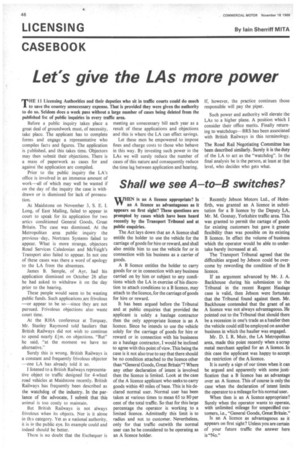Shall we see A—to—B switches?
Page 48

If you've noticed an error in this article please click here to report it so we can fix it.
WitN is an A licence appropriate? Is A licence as advantageous as it appears on first sight? These questions are prompted by cases which have been heard recently by the Transport Tribunal and at public enquiries.
The Act lays down that an A licence shall entitle the holder to use the vehicle for the carriage of goods for hire or reward, and shall also entitle him to use the vehicle for or in connection with his business as a carrier of goods.
A B licence entitles the holder to carry goods for or in connection with any business carried on by him or subject to any conditions which the LA in exercise of his discretion to attach conditions to a B licence, may attach to the licence, for the carriage of goods for hire or reward.
It has been argued before the Tribunal and at public enquiries that provided the applicant is solely a haulage contractor then the only appropriate licence is an A licence. Since he intends to use the vehicle solely for the carriage of goods for hire or reward or in connection with his busineess as a haulage contractor, I would be inclined to agree with this point of view. This being the case is it not also true to say that there should be no condition attached to the licence other than "General Goods, Great Britain"? Where any other declaration of intent is involved then the licence is limited. Look at the case of the A licence applicant who seeks to carry goods within 40 miles of base. This is his declared normal user. Normal user has been taken at various times to mean 65 to 80 per cent of the total traffic. So that for this large percentage the operator is working to a limited licence. Admittedly this limit is to radius and not to customer. Nevertheless, only for that traffic outwith the normal user can he be considered to be operating as an A licence holder. Recently Jebson Motors Ltd., of Holmfirth, was granted an A licence in substitution for a B licence by the Deputy LA, Mr. M. Gosnay, Yorkshire traffic area. This was granted to permit the cartage of goods for existing customers but gave it greater flexibility than was possible on its existing B licence. In effect the volume of business which the operator would be able to undertake barely increased at all.
The Transport Tribunal agreed that the difficulties argued by Jebson could be overcome by rewording the condition of the B licence.
If an argument advanced by Mr. J. A. Backhouse during his submission to the Tribunal in the recent Regent Haulage case is valid, then Jebson were fortunate that the Tribunal found against them. Mr. Backhouse contended that the grant of an A licence was not always advantageous. He pointed out to the Tribunal that should there be a recession in one's trade as a haulier then the vehicle could still be employed on another business in which the haulier was engaged.
Mr. D. I. R. Muir, the LA Metropolitan area, made this point recently when a scrap metal merchant applied for an A licence. In this case the applicant was happy to accept the restriction of the A licence.
It is surely a sign of our times when it can be argued and apparently with some justification that a B licence has an advantage over an A licence. This of course is only the case when the declaration of intent limits the operator to a mileage for his normal user.
When then is an A licence appropriate? Surely when the operator wants to operate, with unlimited mileage for unspecified customers, i.e., "General Goods, Great Britain."
Is an A licence as advantageous as it appears on first sight? Unless you are certain of your future traffic the answer here is "No."




































































































































